As a proud dog parent, seeing your puppy explore the world for the first time is great.
With its boundless energy, an inquisitive puppy is a joy to watch.
But what are the rules when it comes to playing, and should you let your puppy play with big dogs?
Let your puppy play with big dogs only under supervised conditions. Since there is a big difference in size and weight, you shouldn’t leave your puppy alone while playing with larger dogs to prevent any possibility of injury.
Although it might seem scary, playing with larger dogs is a fantastic way for your puppy to learn early socialization and exercise.
In this article, I’ll explain why it’s good for your puppy to learn about the world through playing with big dogs.
I’ll also explore what you should watch out for if you give this a shot.
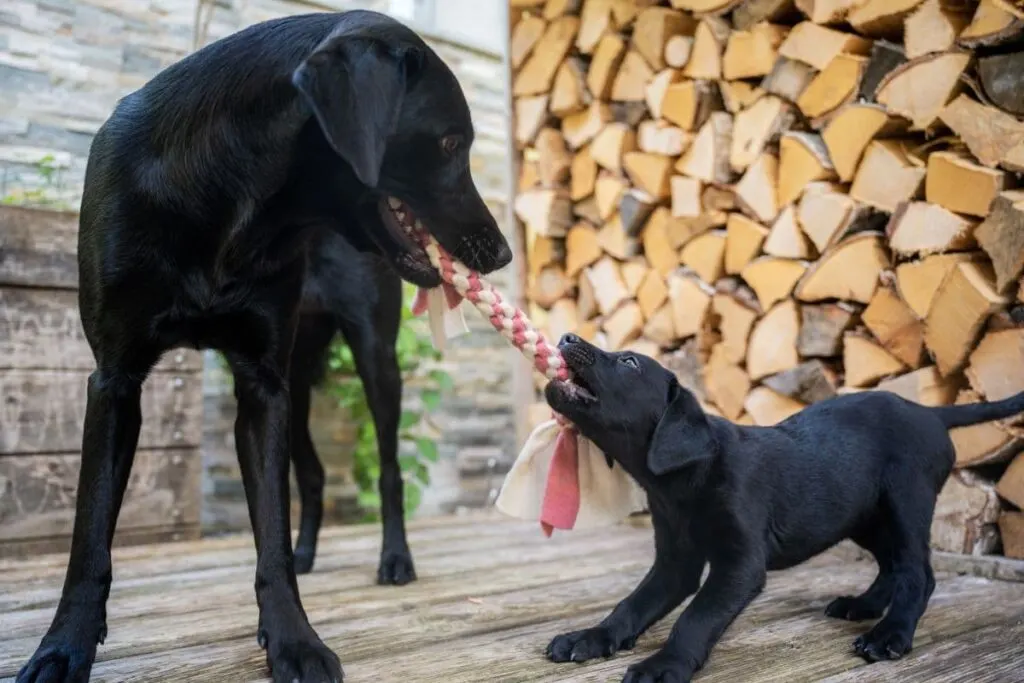
Click Here to Jump to a Section
Is It Safe for a Puppy To Play With Big Dogs?
It can be safe for your puppy to play with big dogs but under the watchful eye of both owners.
This first socialization with other dogs is extremely important in the formation of the behavior of your puppy in the future, so here are a few things you should keep in mind when preparing for the first playdate with a big dog:
1. Make Sure Your Puppy Has All of Its Shots
Before you even think about letting your puppy explore playing with other dogs, it must get all its shots beforehand.
There are many bacteria and diseases your puppy can come into contact with when socializing, such as the following:
- Bordetella bronchiseptica
- Canine distemper
- Hepatitis
- Parainfluenza
- Kennel cough
- Parvovirus
- Coronavirus
All of these are a danger to a little puppy, but some of them can even be deadly, so prevention is of utmost importance when it comes to its health.
Bigger dogs have better immune systems and have gotten their shots already, so they won’t be affected the same way your puppy will if they happen to get sick.
Also, make sure your puppy plays with dogs that are vaccinated, too.
2. Don’t Wait Too Long
When your puppy is learning early socialization, it’s important not to wait too long.
Mary Thompson, the owner of Happy Hound University and a certified dog trainer, sums it up beautifully by saying:
“Lots of positive experiences with new scenarios result in an adult dog who is able to happily and confidently navigate their world.
In contrast, an under-socialized puppy who isn’t taken out until they are five or six months is going to be more apprehensive and pessimistic about novel situations.
Sadly, lack of socialization can lead to fearful or aggressive behavior as an adult dog.”
So, even though it might feel like you are protecting your puppy out of fear of disease or injury, you are actually doing it a disservice.
The sooner it meets other dogs and starts playing with them, the higher its chance of staying happy, social, and curious.
3. Choose a Familiar Turf
When you decide to familiarize your puppy with big dogs, make sure to pick a familiar ground.
The best option would be to have a playdate at your house.
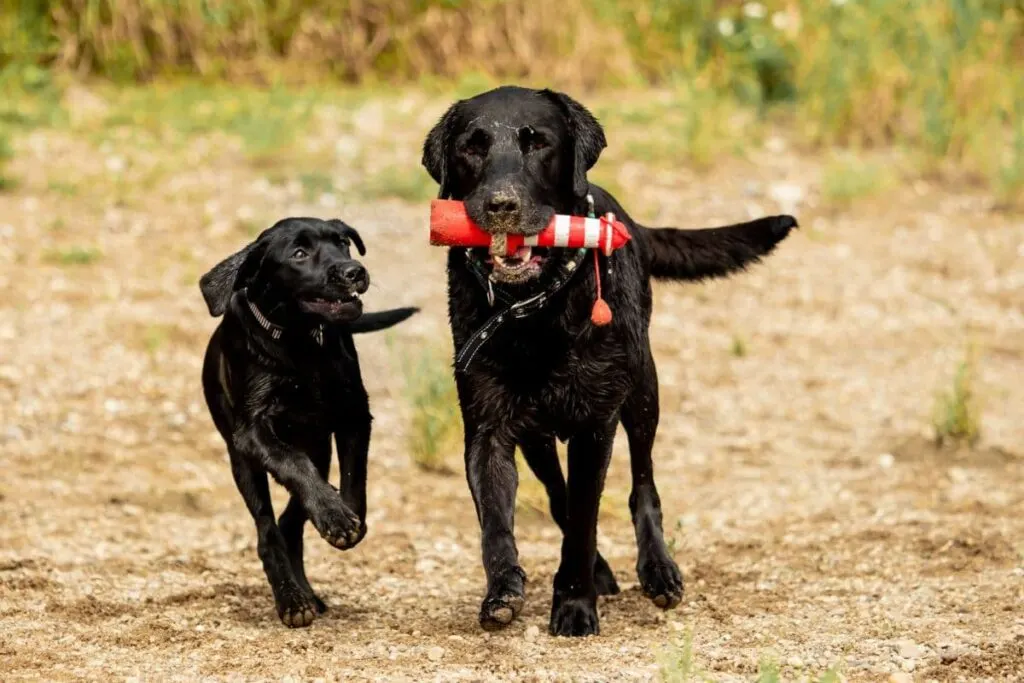
This way, your puppy will feel safer and more relaxed.
Also, it’s a good idea to start the introduction with the big dog on a leash or your puppy behind some dog barriers or baby gates.
I recommend the MYPET Portable Pet Gate
These gates are easy to install, keeping your puppy safe when meeting new friends for the first time, and are an excellent fit for all standard-size doors.
If the interaction between your puppy and the big dog proves friendly and gentle, you can remove the gate and let them interact unencumbered.
If the big dog shows aggression and the playtime starts to go wrong, it is best to separate the dogs and find another big pal for your puppy.
4. Make Sure the Other Dog Isn’t Too Big
When you decide your puppy is ready to start playing with big dogs, the unwritten rule is there should be a maximum of 15 pounds (7 kg) of weight difference.
Dogs that are much larger and heavier than your pup can accidentally injure it or even crush it.
However, if your puppy’s playmate is bigger than that but has a calm disposition and doesn’t play too energetically, this can still be a good fit.
5. Choose a Dog You Know
When choosing a suitable colossal playmate for your puppy, pick a dog you know.
This way, you will know in advance how the dog acts.
Also, make sure it plays well with puppies.
Look for behavior like the big dog slowing down to allow the puppy to catch up or even laying down on the floor to be at the same level as your puppy.
Some big dogs just don’t like puppies or are even afraid of them, so picking the right dog is crucial.
Remember: the big dog needs to be well-trained and obedient.
This way, if anything happens and things go south, you know it will respond to its owner’s commands and move away from the puppy.
6. Make Sure the Other Dog Isn’t Aggressive
When picking the right new friend for your puppy, the big dog must have a good disposition and not be aggressive.
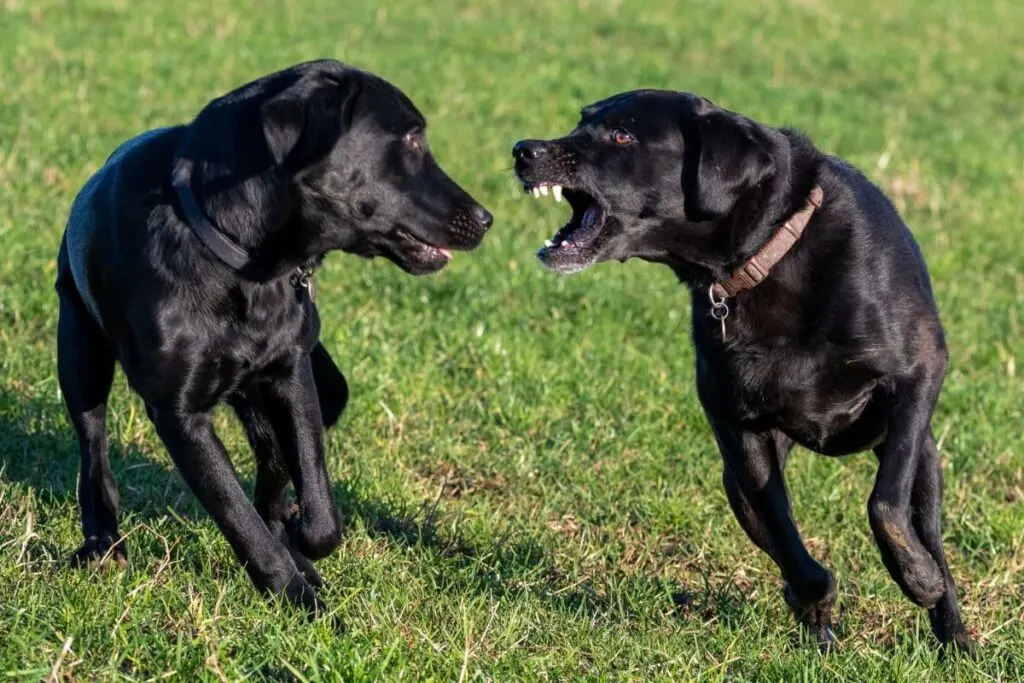
Small puppies can be a bit much for older dogs and can even get on their nerves with their boundless energy.
If the big dog is aggressive, it can interpret your puppy’s attempts to play as aggression and may attack it.
This kind of attack can easily injure or even kill your new puppy.
This is why it’s imperative that the big dog has already interacted with puppies and is known to be gentle and patient with them.
When considering temperament, consider whether the big dog likes to chase things.
Because of its diminutive size, your puppy can look like prey to bigger dogs.
If your puppy starts to run or zig-zag all over the place, it can trigger pursuit predation in the bigger dog.
Even though its intention is not specifically to hurt your puppy, this is ingrained in carnivore predators, which our dogs, despite their loving, docile natures, still are.
There are even certain kinds of dogs with high prey drive and others that are bred to chase prey, which can put your puppy in danger of getting injured or even killed.
Typically, these breeds include the following:
- Dobermans
- Malamutes
- Huskies
- Afghan Hounds
- Bullmastiffs
7. Learn To Differentiate Between Playing and Aggression
Sometimes, it might seem like the dogs are playing overly aggressively, so it is vital to know the difference between play and fighting.
Sometimes a bit of growling and barking is just a form of excitement and is nothing to worry about.
However, keep a close eye on the dogs, and if it seems like there is something wrong, separate them immediately.
Look for these signs when checking for true (versus playful) aggression:
- Staying still and very rigid
- Growling and showing their teeth
- Ears flattened to the back of the head
- Raised fur
If you see these signs, separate the big dog from your puppy immediately.
If, however, the dogs are exposing their bellies, jumping around, and seeming relaxed, you can relax too.
8. Limit the Number of Big Dogs Your Puppy Interacts With
It would be best to limit the number of dogs to one when you first start socializing your puppy.
Dogs can get pretty riled up when playing together, fighting over a toy, or playing tug-a-war, and they won’t always be able to take into account that your puppy is so much smaller than them.
Introducing the puppy to only one dog at a time will ensure it doesn’t get in the way of any wild games.
It should also prevent accidents, like your puppy getting in between two larger dogs rolling around and tussling for toys.
9. Supervise the Playtime
Although it might seem that your puppy and the big dog are getting along swimmingly, don’t let them leave your sight.
A pretend fight can quickly turn into a real one.
The older dog might have a lower energy level than your little furball, and the puppy might start to get on its nerves.
Even if everything goes perfectly, it’s still best to stay by their side to protect your pup and give him the feeling of safety and confidence to explore on his own.
10. Make Sure Your Puppy Has a Good Time
Initial interactions with other dogs stay ingrained in your puppy’s behavior for the long run.
Make sure these interactions are favorable for the pup, as this will ensure it doesn’t develop fear or aggression toward other dogs in the future.
Commend your puppy when it is playing nicely since this will provide positive reinforcement and help the little furball to develop its social skills.
How Do I Teach My Puppy To Play Gently With Other Dogs?
The best way to teach your puppy to play gently with other dogs is to motivate it with positive reinforcement, such as treats and favorite foods, when it plays nicely.
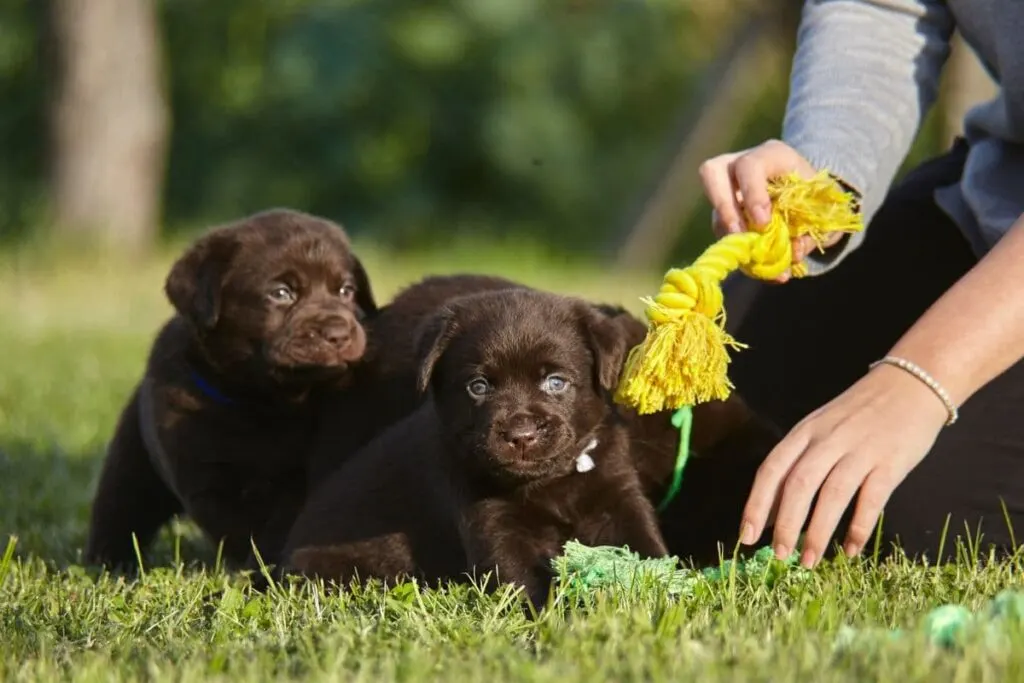
Encourage it to play and be positive and relaxed, and as soon as the gameplay becomes too rough, separate the dogs.
Even before the dogs start to play, at the first encounter, reward both dogs with treats as long as they behave well.
The approach should be gradual and safe.
If the first contact goes smoothly, allow them to play, but only under your constant supervision.
The best way to do that is to give the dogs a toy and encourage them to play with it together.
In time, your puppy will learn that good behavior is rewarded, and bad behavior leads to the end of socializing.
When Should I Stop My Puppy From Playing With My Older Dog?
Stop your puppy from playing with your older dog as soon as you notice the older dog is starting to lack energy or is getting nervous; both are signs that it’s done playing for the time being.
The best thing is to let the older dog dictate the amount of playtime since older dogs usually lack the energy puppies have.
Puppies are usually little balls of inexhaustible energy that just run around the house all day.
As such, they are great for older dogs because these energetic pups keep your dog active.
However, it is easy for the puppy to become a bit much for the older dog; if that happens, the older dog will show it.
In that case, separate them to avoid any potential roughness and injury to your pup.
Keep in mind that, in the same way kids learn about life from their parents and older siblings, socialization between your puppy and the older dog will do wonders for both.
The older dog can teach your puppy good eating and toilet habits and help them prepare for socialization with other dogs.
It is also quite helpful to have an older dog already when you bring the new puppy home, as it can give the pup a sense of protection and security in new and unfamiliar surroundings.
Your older dog can even be beneficial as a great example when you start with obedience training for your pup.
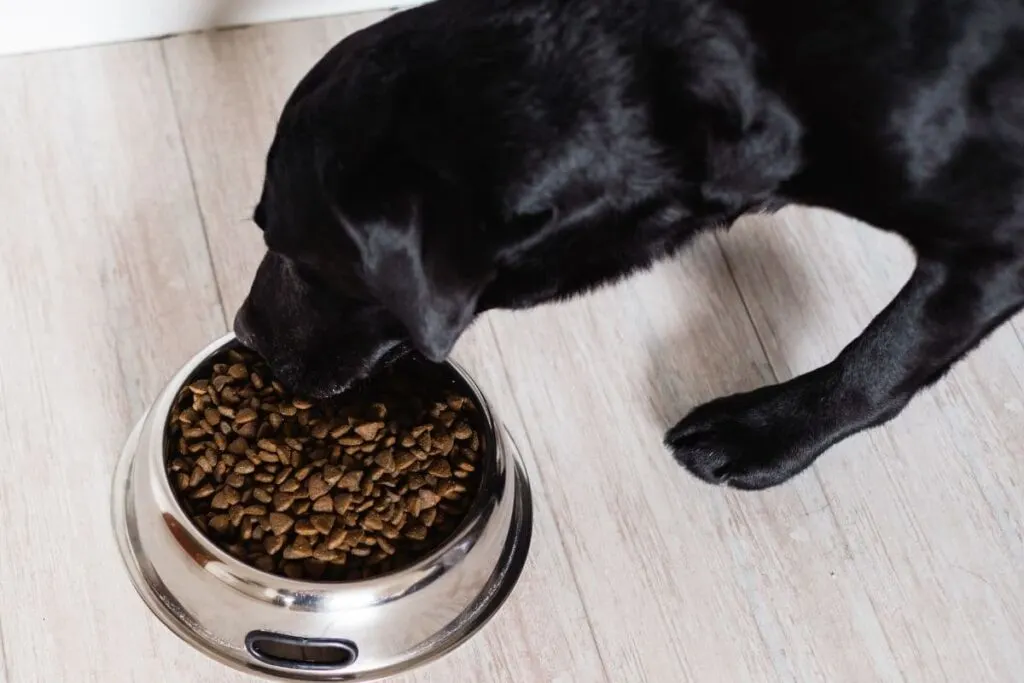
Also, in the context of letting puppies play with big dogs, we often tend to feed them together, to encourage socialization.
This is an okay practice as long as you ensure both dogs (big and small) eat their own recommended dog food.
Giving food that’s intended for puppies or small dog breeds to a big dog can lead to health issues.
To know more, check out my article on whether big dogs can eat small-breed food. [Can Big Dogs Eat Small Breed Food?]
Final Thoughts
Playing with big dogs can be a vital part of your puppy’s growth.
It can teach it how to act and play with other animals and how not to be afraid of bigger dogs.
However, because it’s such a crucial component in the future socialization skills of your pup, it’s vital to ensure this is a good and safe experience for both dogs.
Picking the right environment and a calm pal to play around with will prepare your puppy for what lies ahead.
And always keep in mind your puppy’s health – no playing with others until it’s received its vaccines!
